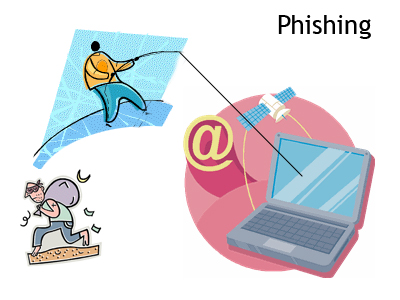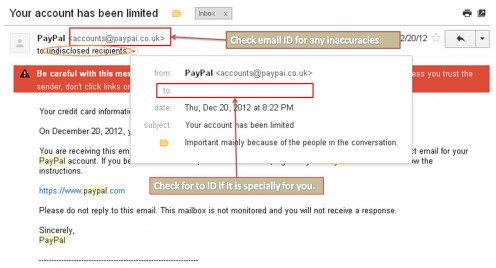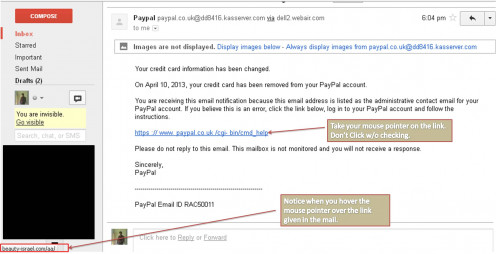How To Check For Phishing Emails?

Flip Side of Technology
Dear reader,
In current times, almost everyone uses computer and hand held devices to avoid unwanted traveling for bill payments, some also use internet for making money online. These, possibly, are some of the best things we have received from advancement in science and technology. However, every coin has two sides.
For people like us, who use online services for making and receiving payments, will know that we need to provide our email address for alerts and information regarding updates and upgrades. The companies, who provide such crucial facilities, have very high level of security for anyone to breach in. Such companies do not share any of your details with other company or individual, as well, which is good. However, we often visit different, unknown websites, where we share our email ID to subscribe for their updates. Some of such sites may be like Elephant’s teeth. They showcase something different and their purpose might be something entirely different, rather sinister.
How It Works?
Once such groups have collected a bunch of email ids, they create websites which look exactly like other money transferring sites, for example Paypal look-a-like. Such websites, lets call them LAL sites, will have exact front end, which we see with all login boxes and other details, as that of original one. Such emails often have subjects like “Your Credit has been limited.” which will make you to enter your details to check your account status. Hence you click on the link given in the email, without thinking twice.
Now that you are on LAL site, without noticing anything else, you will login in straight away by entering your login id and password. Now you may be redirected to another link which may or may not work. If it does, it will ask you to put in your Credit Card or Bank account details to raise the limit. You often end up providing your login details and in some cases Credit Card and Bank account details to LAL site holders for your real account. Once they have got all your details, they don’t need you anymore and will let you know everything has been set to normal.
Now LAL sites will have all your details and will be working on transferring funds from your account and credit card to theirs’.
What is Phishing?
How to check if an email is Phishing or real?
After going through a few such emails, I receive such emails at least once a month; I derived a few ways to verify any such email received. Do not worry, even if you have rudimentary knowledge of email and internet, you can still work it out.

1> To start with, when you open any such email, check ‘From’ Email address, as shown in the image. Original email from real company will not be sent through/via any other server or service provider, also known as proxy server.
The other thing to notice in the ‘From’ email address is spelling of the address and extension. Here you need to check your email from original service provide if they use ‘.com’ extension. Often they make a minor difference in spelling which can be overlooked by the receiver.
For example, Paypal uses ‘.com’ extension thereby its URL is Paypal.com. If you see Paypal.co.uk, which has inconsistency in the extension, or Paypai.com, which has incorrect spelling – I replacing L – then don’t click on any link given in the mail.
2> If the ‘From’ email address looks fine, check for ‘To’ email address. Original websites do not shoot out emails with such Subject (As one above) to anonymous or multiple email ids thereby leaving ‘To’ field empty. If ‘To’ field is empty, it means it was send to multiple users which raises questions about its authenticity. Again, if the email fails here, don’t click on any link given in the email.

3> Now the final check, let’s say everything is fine in ‘From’ and ‘To’ field, there is a last thing to verify. Check the link given in the mail. How to do it? Well, it is very simple. Take your mouse pointer over the link, make sure you don’t click before verifying. Once you put your pointer over the link, its actual URL or website address will be show at the bottom of the screen, as shown in the image above. (In Firefox its on the bottom right corner. On other browsers it will be shown but may be at different location.) Now keep your mouse pointer over the link given in the mail, without clicking it, and check the URL or Website address shown by the system.
In Phishing emails, such links have different display name than one shown in the email. If there is a minor difference, for example spelling mistake or different extension or in some cases an entirely different URL. Don’t click on the link as it definitely is a Phishing email.
Avoid Any Type of Conundrum
Finally, in any case, if you are stuck in some type of conundrum, where everything looks fine but you are still skeptic, you always have the option to open the website by entering the website address and open it in your browser. By doing this, you will avoid clicking on any link from the mail and will go to the original service provider directly.
These are a few very basic tricks to check an email which I have derived and use. Try it once, you can thank me later [Nudge, Nudge, Wink, Wink].
Jokes apart, I will come up with more solutions to prevent ourselves from being victims.
Thank you for reading. [Smiles]
Is it useful?
Keep Reading!!!
- That’s Impossible: Invisibility Cloak
A documentary by History channel, narrated by Jonathan Frakes, is about remarkable advancement in the field of Science to make our dream of becoming 'Invisible' true. Intriguing and Exciting indeed!!! - Imagination, Curiosity and Creativity
Imagination, Curiosity and Creativity together can create wonders. In order to bring them together we first need to understand what they mean and how to bring them together. - Hot & Sour Techno-Cheese Cake
In the current times when our life is dependent on technology, most of us overlook the actual sides. How about taking some time off to know a little about something we use a lot. - WoW Chizz Cake
This article is based on the experiences and observations of human behavior along with the information collected from different places. I have tried to explain the relation between Faith and outcome of Self-Effort. I would be glad to know more about - Dark Sides of Technology - 1
Disadvantages of Automation.
© 2013 NISARG MEHTA

![McAfee 2017 Internet Security - 3 Devices [Online Code]](https://m.media-amazon.com/images/I/91gOMHdwMEL._SL160_.jpg)








